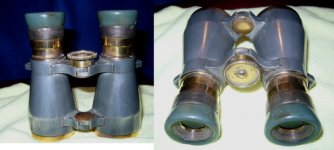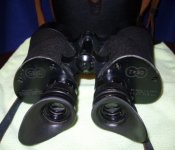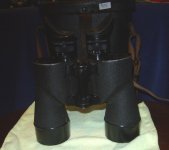Hans Weigum
Well-known member
Not to have gradually to repeat in portions, here an old contribution again as a whole:
Bird Forum: Saturday 11th October 2008, 12:51 #21
Hans Weigum
Kern/Leica 8x30 (K/L), history and systematic description
This contribution is a slightly adapted version of a text I wrote some time ago, and therefore does not refer individually to some quite speculative statements made previously in this forum.
1.This unique design was initiated by a contract by the Swiss Army to Kern with the main goal of lowering costs of procurement and maintenance, improving mechanical resistance, while maintaining, not necessarily increasing optical performance.
2. This was mainly achieved with the, to my knowledge, first time successful large scale application of a special single hinge design. The mating surfaces of each half bino get machined after assembly of the optics such, that by joining two completed random taken halves, they get sufficiently collimated without additional means .
3. Earlier military Kern 8x30 only seem to look unchanged for decades. Originally they were slightly modified copies of the well known design of CZJ with a five lens eyepiece with telescopic cups. The last version of the forerunner of the K/L discussed here, however, adopted already the three lens design with rubber cups which the K/L design continues to use.
4. Following versions of the basic design are known to exist:
4.1 IF, “Kern” branded on black (=no laser filter fitted) plastic hinge cap: Inverted T-shaped reticle pattern: Original, today rare version, as most got a laser filter retrofitted later (see 4.2.)
4.2 As above, but with blue Kern (also Leica?) hinge cap (=w. laser filter) retrofitted (or also originally fitted?) often also with blue sticker (mentioning the filter) near one of the objectives. These retrofitted filters cemented (to the prisms ?) happen to separate in time, visible then as a brown tint when looking reversely through the optics.
4.3 As above but with a blue "Leica" hinge cap: Originally fitted with a better designed laser filter with so far no loosening problems known. Separately fitted, not cementd?
4.4 As above with black "Leica" hinge cap: Very limited civilian sales version w/o laser filter and w/o reticle
.
4.5 As above, but with adapter (for a "Bolex" monopod ) carrying the inscription: ”Flab”( =abbreviation for Fliegerabwehr) in line with hinge axis. Sun glare filters (for eyepieces) are stored in a small leather pouch attached to carrying sling. Complex reticle designed to be used for air target identification.
4.6. CF civilian-only version made by Kern, sold as "Pizar Elit", very few made, sold rather as a by-product of the army contract. No laser filter or reticle fitted.
5. As suggested in an earlier contribution, the K/L binos were a pure Swiss venture initiated by Kern, later continued by Leica Geosystems military department (now Vectronix), completely separate to Leica Cameras( Germany) line of binoculars. It might even be, that when Leica took over Kern, mainly interested in their surveying instrument business, was not eager, but rather obliged to continue supplying binoculars to the Swiss government, and therefore did not try to sell them elsewhere. Apart from the few 4.4.and 4.6. types directly sold to civilians, K/L were only supplied to the Swiss Army and Border Patrol, but in quite considerable numbers relative to the size of Switzerland.
11.10.08weigum
So contrary to suggestions made above, the special design of the Kern/Leica was selected to lower costs of production and maintenance. Fewer parts are required and assembly time considerably reduced as no collimation work proper has to be performed.
Why such design has not been previously been applied? Because it only seems to be simple. Bell&Howell tried a similar approach with their military 7x50 M19. There preadjusted units instead of individual components should have got changed for repair. An approach that reportedly never did work properly. RUAG, however, the Swiss Army's industrial branch, performs large scale scheduled maintenance of Kern/Leicas obviously on regular basis, as I could witness myself.
A further indicator, that a technology transfer from Leica to Kern (for this 8x30 design) was most unlikely, can be taken from the fact, that it was in fact the company Wild, that was taking over both Kern and Leica (Cambridge Instruments and Reichert as well) within a short period. Wild later adopting the name Leica for the whole conglomerate.
Property of design and probably special tooling of K/L 8x30 might be with RUAG, not Leica, nor its present day military optics successor Vectronix.
It might as well be, that when Kern was closing, Wild/Leica might have subcontracted production of the Kern/Leica to the independent optical producer FISBA.
Hans
Bird Forum: Saturday 11th October 2008, 12:51 #21
Hans Weigum
Kern/Leica 8x30 (K/L), history and systematic description
This contribution is a slightly adapted version of a text I wrote some time ago, and therefore does not refer individually to some quite speculative statements made previously in this forum.
1.This unique design was initiated by a contract by the Swiss Army to Kern with the main goal of lowering costs of procurement and maintenance, improving mechanical resistance, while maintaining, not necessarily increasing optical performance.
2. This was mainly achieved with the, to my knowledge, first time successful large scale application of a special single hinge design. The mating surfaces of each half bino get machined after assembly of the optics such, that by joining two completed random taken halves, they get sufficiently collimated without additional means .
3. Earlier military Kern 8x30 only seem to look unchanged for decades. Originally they were slightly modified copies of the well known design of CZJ with a five lens eyepiece with telescopic cups. The last version of the forerunner of the K/L discussed here, however, adopted already the three lens design with rubber cups which the K/L design continues to use.
4. Following versions of the basic design are known to exist:
4.1 IF, “Kern” branded on black (=no laser filter fitted) plastic hinge cap: Inverted T-shaped reticle pattern: Original, today rare version, as most got a laser filter retrofitted later (see 4.2.)
4.2 As above, but with blue Kern (also Leica?) hinge cap (=w. laser filter) retrofitted (or also originally fitted?) often also with blue sticker (mentioning the filter) near one of the objectives. These retrofitted filters cemented (to the prisms ?) happen to separate in time, visible then as a brown tint when looking reversely through the optics.
4.3 As above but with a blue "Leica" hinge cap: Originally fitted with a better designed laser filter with so far no loosening problems known. Separately fitted, not cementd?
4.4 As above with black "Leica" hinge cap: Very limited civilian sales version w/o laser filter and w/o reticle
.
4.5 As above, but with adapter (for a "Bolex" monopod ) carrying the inscription: ”Flab”( =abbreviation for Fliegerabwehr) in line with hinge axis. Sun glare filters (for eyepieces) are stored in a small leather pouch attached to carrying sling. Complex reticle designed to be used for air target identification.
4.6. CF civilian-only version made by Kern, sold as "Pizar Elit", very few made, sold rather as a by-product of the army contract. No laser filter or reticle fitted.
5. As suggested in an earlier contribution, the K/L binos were a pure Swiss venture initiated by Kern, later continued by Leica Geosystems military department (now Vectronix), completely separate to Leica Cameras( Germany) line of binoculars. It might even be, that when Leica took over Kern, mainly interested in their surveying instrument business, was not eager, but rather obliged to continue supplying binoculars to the Swiss government, and therefore did not try to sell them elsewhere. Apart from the few 4.4.and 4.6. types directly sold to civilians, K/L were only supplied to the Swiss Army and Border Patrol, but in quite considerable numbers relative to the size of Switzerland.
11.10.08weigum
So contrary to suggestions made above, the special design of the Kern/Leica was selected to lower costs of production and maintenance. Fewer parts are required and assembly time considerably reduced as no collimation work proper has to be performed.
Why such design has not been previously been applied? Because it only seems to be simple. Bell&Howell tried a similar approach with their military 7x50 M19. There preadjusted units instead of individual components should have got changed for repair. An approach that reportedly never did work properly. RUAG, however, the Swiss Army's industrial branch, performs large scale scheduled maintenance of Kern/Leicas obviously on regular basis, as I could witness myself.
A further indicator, that a technology transfer from Leica to Kern (for this 8x30 design) was most unlikely, can be taken from the fact, that it was in fact the company Wild, that was taking over both Kern and Leica (Cambridge Instruments and Reichert as well) within a short period. Wild later adopting the name Leica for the whole conglomerate.
Property of design and probably special tooling of K/L 8x30 might be with RUAG, not Leica, nor its present day military optics successor Vectronix.
It might as well be, that when Kern was closing, Wild/Leica might have subcontracted production of the Kern/Leica to the independent optical producer FISBA.
Hans
Last edited:







